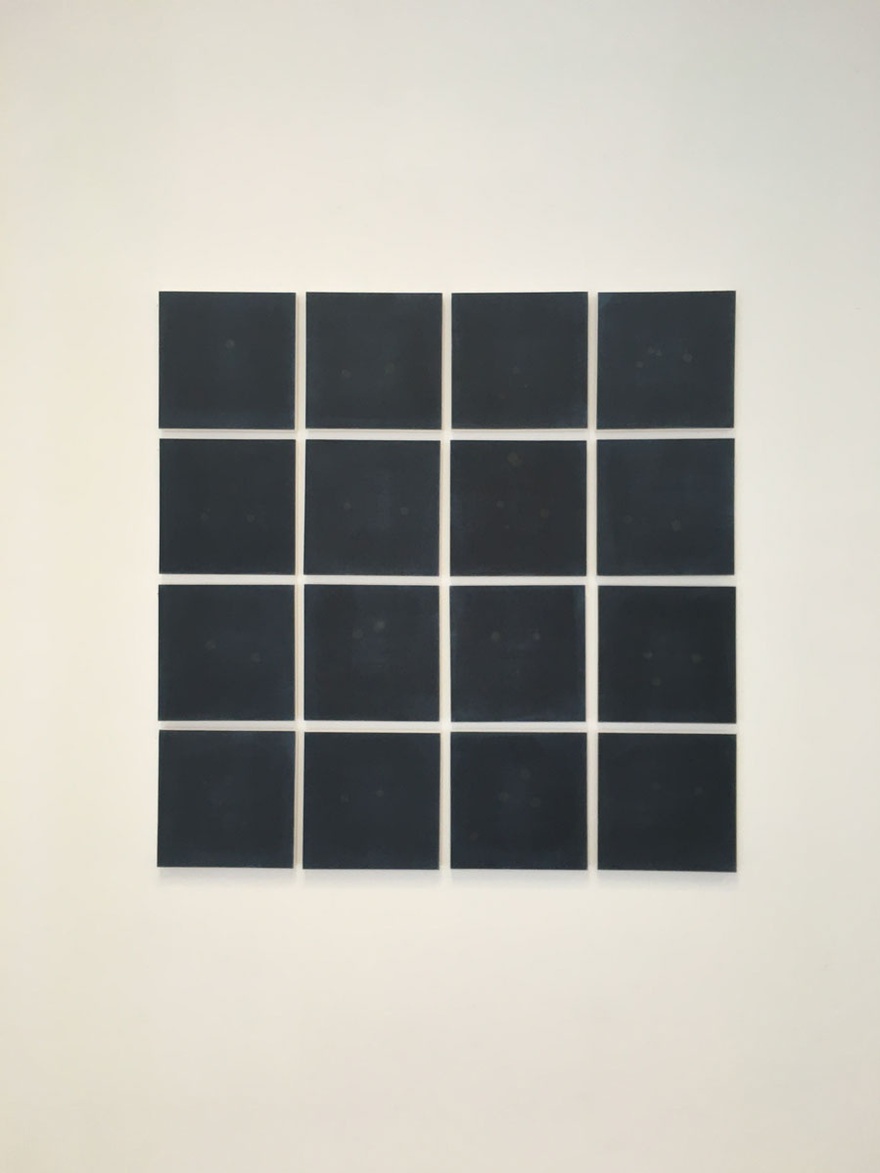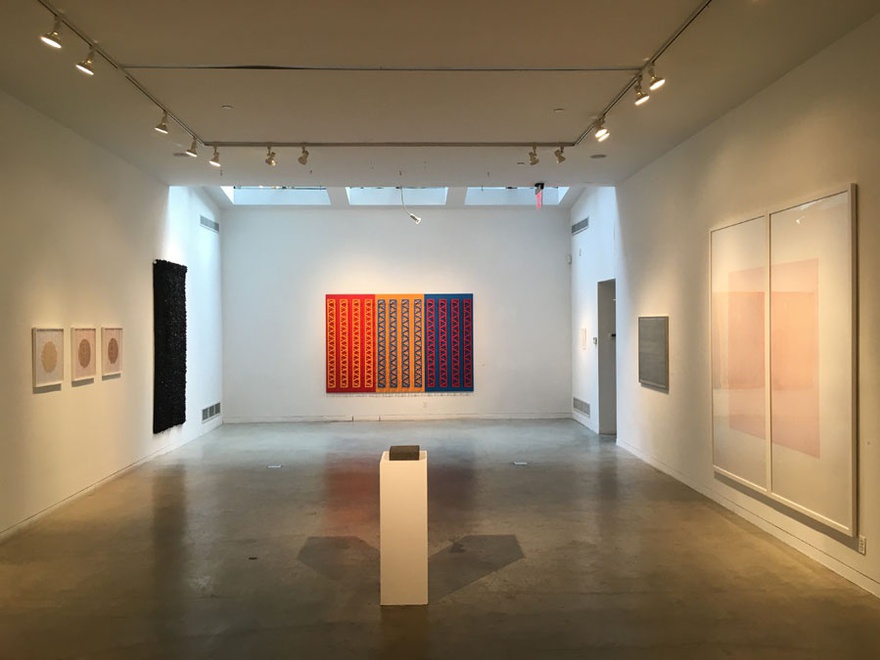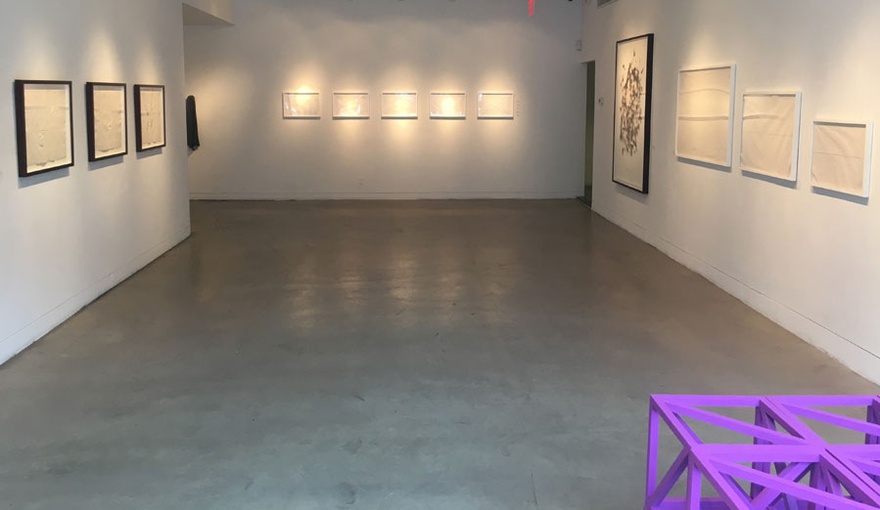Reviews
Between Structure and Matter: Other Minimal Futures
At Aicon Gallery, New York
Curated by Murtaza Vali and Prajit Dutta, Between Structure and Matter: Other Minimal Futures featured eleven artists spanning several generations, hailing from Bangladesh, India, Madagascar, Pakistan, Tunisia, and the United Arab Emirates, including: Joël Andrianomearisoa, Minam Apang, Rasheed Araeen, Hemali Bhuta, Shilpa Gupta, Somnath Hore, Nadia Kaabi-Linke, Jitish Kallat, Mohammed Kazem, Waqas Khan, and Abdullah M. I. Syed. In a historicizing manner, Vali and Dutta positioned these artists within the discussion surrounding the history – or histories – of abstraction and Minimalism. The works selected considered the claim made by the art historian and chief curator of the Dia Art Foundation in New York, James Meyer, a scholar of Minimalism. Meyer described the 1960s movement surrounding minimalism as one mainly characterized by a pared down, unexpressive, distilled sensibility that is also a complex artistic movement with contrasting practices, non-iconic, non-hierarchical strategies, and one with a bridging relation to postmodernity. Thus, while Meyer championed American artists like Carl Andre, Dan Flavin, Donald Judd, Sol LeWitt, Robert Morris, and Anne Truitt of the Post War second generation New York art scene, Vali and Dutta look toward an alternative parallel by contemporary artists from South Asia, North Africa, and the Middle East.
The show includes recent as well as pioneering artworks that map out the minimalist trajectory over the last half-century. Among the younger artists was Andrianomearisoa, whose fabric wall sculptures (there are four variations scattered throughout) are composed of strips of denim, indicating the apparel and textile manufacturing and export industry in Madagascar. Titled, OKMARCLAURENT77MONDAY BOY (2016), one work hung at the entrance to the gallery along with Perspectives, Bank Junction, London (2014) by Nadia Kaabi-Linke: a drawing made with varnish on acrylic that casts a shadow on a white wooden surface, depicting the financial district in London, referring to the financial crisis – both works reflecting on the influences and downfalls of capitalism.
The legacies of two artists, Rasheed Araeen and Samnath Hore, offered historical anchors for what might have seemed to be mutually exclusive elements within this exhibition: politics and minimalism in a fragmented, non-exclusive global narrative. Araeen's Teen Rungh Upper Nechay (Triptych) (2016) hung on a prominent central wall in the white cube of the gallery space. Characteristic of Araeen's post-minimalist style, the work is made up of three wooden panels, each painted either blue, yellow, or red, overlaid with Araeen's signature structures composed of columns of skeletal cubes with bisecting diagonals painted in the same colours.When Araeen moved to London from Karachi in 1964 after completing his civil engineering degree, he had not yet encountered the works of the American minimalists. By the mid-1960s Araeen had abandoned engineering and focused on art concerned with industrial materials and colour, creating structures influenced by the steel girders he had once worked with as an engineer. As in such cases of 'multiple independent discovery', Araeen's artistic beginnings and oeuvre are a fascinating narrative of an artist working on similar questions at the same time as his New York counterparts.
Somnath Hore's Untitled (Wounds) (1970–73) occupied the length of one of the gallery's walls in an adjoining space to the room in which Araeen was presented. Made from a striking sequence of cast paper, the surface of each handmade piece is marked with impressions and subtle cavities that resemble fossilized lacerations, scars, slits, and abrasions on skin marred by violence. Using knives and hot iron prods, Hore cut into and burned pieces of clay that would later become models for the paper pulp reliefs. The marks, recalling the trauma of political history in South Asia, which the artist had been a witness to, act as a striking example of minimalism with a visceral, emotionally engaged, particular political content. This kind of duplicity seems to be at the heart of the practices by many of the exhibiting artists, and represents a definitive distinction from the object-oriented New York School, whose protagonists explicitly argued against metaphor or self-expression rather than focusing on bring material parts together into cohesive relationships.
In conversation with Hore's Wounds are a series of five delicate Tree Drawings (2013) by Shilpa Gupta. Among them are 1:1547703 Olive Tree or 1:6235011 Mangrove, composed of white thread glued to white paper, with a ratio and text inscribed in graphite at the bottom of each page, they depict trees found on various borders, the length of thread in ratio to the length of fences erected on these borders where the trees can be found. Continuing with markings on paper is one of two works by Jitish Kallat, Wind Study I (The Hour of the Day of the Month of the Season) (2016) made with flammable liquid, painted over a graphite drawing on paper, where the artist works with the wind, which controls the direction and intensity of the flame. While Mohammed Kazem's Untitled (Red) (2015) and Untitled (White) (2016) from his scratches series are visual representations of sound made by scratching paper with scissors. Waqas Khan's ink drawings on paper Each Other All Along (2016) plunges you into a sea of repeating minute dots, and Abdullah M. I. Syed's Tears: 16 Midnight Blue Squares (2016), a grid of 16 squares, are made with the artist's tears.
Returning to the frame through which the history of minimalism has so often been read, it is worth recalling what the curator's state in this exhibition's press release. They recount Meyers's suggestion 'that minimalism may be better understood not as a coherent movement or a singular style but as a "field of difference," a "dynamic field of specific practices" that was polemical, contested, and plural from its very inception'. Vali and Dutta list Judd, Flavin, Morris, and Andre, explaining how each had their own criteria for minimalist art: Judd was concerned with form and Andre with matter; Flavin's fluorescent tubes 'flirted with Pop'; and Morris collaborated with the Judson Dance Theater in New York. This is to say, minimalism can be thought of as multiple minimalisms, whereby Araeen's structural explorations, or Hore's bare gesture of imprinting 'wounds' into paper pulp become a shared vocabulary within a set of artistic working strategies and possibilities. Putting South Asian, North African, and Middle Eastern artists in dialogue with the canon of Minimalism complicates its history in order to argue for its reframing today. The intention is to untie the prevailing reductivist tendency toward identity politics and cultural essentialism in order to seek out more nuanced negotiations between the formal, political, informational, and bodily.
Between Structure and Matter: Other Minimal Futures was on view at Aicon Gallery, New York from May 26 to July 2, 2016.








